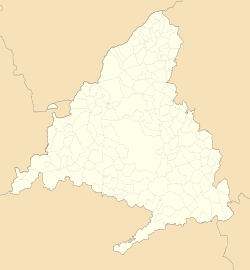Complutum
| Alcalá de Henares | |||
|---|---|---|---|
| Municipality | |||
|
|||
| Location of Alcalá de Henares within the Community of Madrid | |||
| Coordinates: 40°28′N 3°22′W / 40.467°N 3.367°WCoordinates: 40°28′N 3°22′W / 40.467°N 3.367°W | |||
| Country |
|
||
| Autonomous community |
|
||
| Comarca | Comarca de Alcalá | ||
| Founded | Pre-Roman | ||
| Government | |||
| • Alcalde | Javier Rodríguez Palacios (PSOE) | ||
| Area | |||
| • Total | 87.72 km2 (33.87 sq mi) | ||
| Elevation | 594 m (1,949 ft) | ||
| Population (2014) | |||
| • Total | 200,768 | ||
| • Density | 2,300/km2 (5,900/sq mi) | ||
| Demonym(s) | Complutense | ||
| Time zone | CET (UTC+1) | ||
| • Summer (DST) | CEST (UTC+2) | ||
| Postal code | 28801-28807 | ||
| Dialing code | (+34) 91 | ||
| Website | Official website | ||
| University and Historic Precinct of Alcalá de Henares | |
|---|---|
| Name as inscribed on the World Heritage List | |
 |
|
| Location | Spain |
| Type | Cultural |
| Criteria | ii, iv, vi |
| Reference | 876 |
| UNESCO region | Europe and North America |
| Inscription history | |
| Inscription | 1998 (22nd Session) |
Alcalá de Henares (Spanish pronunciation: [alkaˈla ðe eˈnaɾes]), meaning Citadel on the river Henares, is a Spanish city whose historical centre is one of UNESCO's World Heritage Sites. The city stands out for its rich archaeology and was one of the first bishoprics founded in Spain. Located in the Autonomous Community of Madrid, 35 kilometres (22 miles) northeast of the city of Madrid, at an altitude of 588 m (1,929 ft) above sea level, it has a population of around 200,000. Locally, the city is generally known simply as "Alcalá", but "de Henares" is appended when needed to differentiate it from a dozen Spanish cities sharing the name (from the Arabic word al-qal'a القلعة for fortification or citadel). The Latin name, Complutum, is sometimes used. The city is the capital of its namesake region, Comarca de Alcalá.
The city boundaries have been inhabited since the Calcolithic phase of the Bronze Age. Romans conquered the area in the 1st century BC, and built the town of Complutum near a previous Carpetanian settlement, called Iplacea. Thus, it became the only Roman town in the Madrid region. With 10,000 inhabitants, it reached the status of Municipium and had its own governing institutions. After the downfall of the Roman Empire, under the Visigoths, it declined, although it also became a pilgrimage destination in remembrance of the Saints Justo and Pastor.
When the Moors arrived in 711, they subdued the Visigothic city and founded another site, building an al-qal'a, which means "citadel" in Arabic, on a nearby hill, today known as Alcalá la Vieja (Old Alcalá). On 3 May 1118, it was reconquered by the Archbishop of Toledo Bernard de Sedirac in the name of Castile. The Christians preferred the Burgo de Santiuste ("Saint Just's borough") on the original Roman site and the Arab one was abandoned. The city was ceded to the Bishopric of Toledo, which granted it ferial rights. Under Christian rule until the end of the Reconquista, the city had both a Jewish and a Moorish quarter and a renowned marketplace. Its central position allowed it to be a frequent residence of the Kings of Castile, when travelling south.
...
Wikipedia



